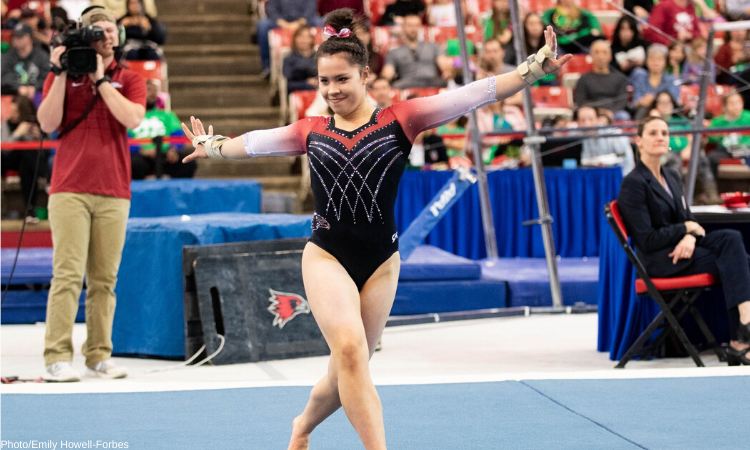It’s time to look at which teams made the largest jumps (and dropped the furthest) in the rankings between 2019 and 2020. Like last year, we looked at which teams improved the most in their overall ranking and NQS, which conferences improved the most on average and how each team with a first year head coach performed.
Despite the unexpected end to the 2020 season, we still wanted to analyze annual rankings changes to highlight teams who were having great seasons in 2020. However, we naturally had to make some adjustments to account for the fact that there was no postseason in 2020. Instead of comparing the final rankings from 2019 to the final rankings from 2020, we instead compared the final regular season rankings from 2019 to the final rankings from 2020.
Division II teams are in blue, Division III teams are in red and USAG teams are italicized.
Somewhat unsurprisingly, SEMO had the largest change in overall ranking, going from No. 70 in 2019 up 17 spots to No. 53 in 2020. 2019 was a rough season for the Redhawks due to a major lack of depth, but they had an incredible 2020 season thanks to a strong freshman class. On a similar note, Towson had the fourth highest jump in the rankings, moving up 10 spots to No. 48, also due to having more depth and a strong freshman class.
Other teams with notable jumps in the rankings include Utah State (+13), North Carolina (+12) and Michigan State (+9). All three teams have struggled the last couple of seasons, and they were all strongly in the postseason conversation before the season’s abrupt end.
Largest Changes in NQS
For many teams, looking at the change in the rankings doesn’t tell the whole story. In these cases, NQS gives a much better picture. This is more noticeable for the NCGA teams, who are often further apart in NQS, so a large change in NQS may not have much of an effect in overall ranking.
As seen in the graph above, generally an increase in NQS leads to an increase in ranking and vice versa. Some notable exceptions include several NCGA teams, for the same reasons mentioned previously.
Division II teams are in blue, Division III teams are in red and USAG teams are italicized.
SEMO is once again the winner in this category, as it improved its NQS by nearly five points from 2019 to 2020. All but one of its 2020 scores was higher than its season high in 2019.
Unsurprisingly, the teams with the second- through fifth-highest jumps in NQS—Ursinus (+2.265), Cortland (+1.760), UW-La Crosse (+1.745) and UW-Whitewater (+1.600)—are all NCGA teams. As previously mentioned, these teams often do not have significant changes in the rankings despite a large change in NQS. This is most notable for Ursinus, which only moved up one spot in the rankings despite improving its NQS by over two points.
Largest Changes by Conference
The next thing we looked at was the average difference in ranking and NQS for each conference.
| Conference | Average Difference in Ranking | Average Difference in NQS |
| Big 12 | -1.000 | -0.029 |
| Big Ten | +0.700 | +0.090 |
| EAGL | +5.000 | +0.380 |
| ECAC I | -1.833 | -0.697 |
| ECAC II | -2.667 | -0.727 |
| MAC | +0.286 | +0.019 |
| MIC | +1.600 | +0.589 |
| MPSF | -0.333 | -0.097 |
| MRGC | -1.250 | -0.001 |
| NCGA-E | -0.167 | -0.275 |
| Pac 12 | +2.375 | +0.078 |
| SEC | -0.500 | -0.108 |
| WIAC | +1.625 | -1.264 |
The conference with the largest increase in ranking from 2019 to 2020 was the EAGL, which improved five spots on average. Four of the six teams in the conference increased their ranking by eight spots or more. It’s also worth mentioning that between 2018 and 2019, the EAGL was the conference with the largest average decrease in the rankings.
The conference with the most improvement in NQS between 2019 and 2020 was the MIC. This is almost entirely due to SEMO’s large increase in NQS, as the other four teams in the conference actually went down in NQS.
Largest Changes from Teams with First-Year Head Coaches
The last point I looked at was the largest changes from teams with first-year head coaches. While there are a variety of factors that can affect a head coach’s first season, it’s still interesting to look at how well each first-year head coach did.
| Team | First Year Head Coach | Difference in Ranking | Difference in NQS |
| Air Force | Jennifer Langley | -7 | -1.320 |
| Arkansas | Jordyn Wieber | +2 | +0.105 |
| Central Michigan | Christine McDonald | -8 | -0.365 |
| Cortland | Sulekha Modi Zaug | +3 | +1.760 |
| New Hampshire | Lindsey Bruck-Ayotte | -7 | -0.410 |
| Seattle Pacific | Sarah Jean Marshall | +4 | +0.975 |
| Towson | Jay Ramirez | +10 | +0.885 |
| UCLA | Chris Waller | -1 | -0.445 |
| William & Mary | Kelsey Hinton | +4 | +0.585 |
The team with the largest increase in the rankings was Towson, which improved 10 spots under first year head coach Jay Ramirez. Towson has had a rough past couple of seasons, but this is a good indication that the tides may be turning. The team with the largest increase in NQS was Cortland, which improved its NQS by nearly two points under rookie leader Sulekha Modi Zaug.
Article by Mary Emma Burton
Like what you see? Consider donating to support our efforts throughout the year! [wpedon id=”13158″]





One comment
Comments are closed.